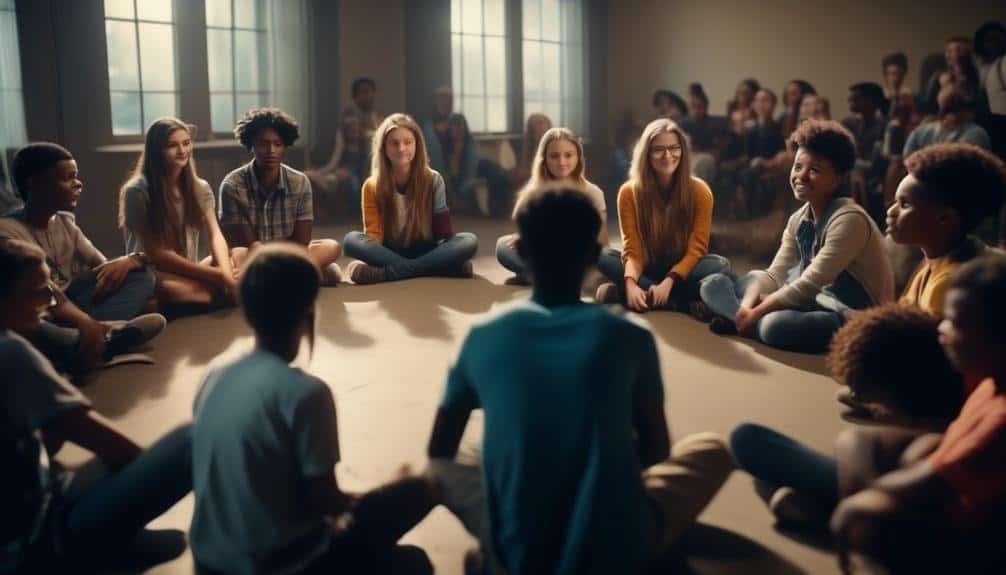Motivating Students: Engagement Strategies for Teachers
You may be thinking, ‘Motivating students is a difficult task, especially with so many distractions and competing interests.’
However, as a teacher, it is crucial to find effective engagement strategies that will captivate your students’ attention and ignite their passion for learning.
By incorporating interactive and hands-on activities, utilizing technology, and creating a positive classroom culture, you can create an environment that fosters curiosity and growth.
But, there’s more to it than that.
Key Takeaways
- Tailoring instruction to incorporate topics that resonate with students increases motivation and engagement.
- Interactive and hands-on activities, such as simulations and experiments, promote active exploration and problem-solving.
- Utilizing technology, such as virtual reality and gamification, enhances learning experiences and motivates active participation.
-
Recent advancements in educational technology offer compelling tools for boosting student motivation. For instance, platforms leveraging AI, like Knowt, provide students with personalized and interactive learning opportunities. This level of customization can refine practice methods, making the material more engaging and enhancing retention.
- Providing timely and constructive feedback supports student growth and improvement.
Understanding Student Interests and Needs
To effectively engage students in the classroom, it’s crucial for teachers to understand their interests and needs. Student motivation plays a significant role in their academic success and overall engagement. Research has consistently shown that when students are interested in a topic, they’re more likely to be motivated to learn and actively participate in the learning process. By understanding their interests, teachers can tailor their instruction to incorporate topics and activities that resonate with students. This individualized instruction helps create a sense of relevance and increases student engagement.
Furthermore, understanding students’ needs is essential for creating a supportive and inclusive learning environment. Each student comes into the classroom with unique strengths, weaknesses, and learning styles. By recognizing and addressing these individual needs, teachers can provide targeted support and differentiate instruction. This approach ensures that all students feel valued and capable of achieving success.
Incorporating student interests and addressing their needs not only enhances student motivation but also promotes a positive classroom culture. When teachers actively engage with their students, they foster a sense of belonging and create an atmosphere where students feel safe to take risks and participate in discussions. By understanding and catering to their interests and needs, teachers can create a classroom environment that promotes active engagement and maximizes student learning outcomes.
Incorporating Interactive and Hands-On Activities
To engage your students in the learning process, consider incorporating interactive simulations and hands-on experiments into your lessons.
Interactive simulations provide a virtual environment where students can actively explore concepts and apply their knowledge in a meaningful way.
Hands-on experiments allow students to manipulate materials and engage in real-world problem-solving, fostering a deeper understanding of the subject matter.
Interactive Simulations for Engagement
Incorporating interactive simulations and hands-on activities is a research-based strategy that promotes engagement in the classroom. Virtual simulations and gamification are key components of this approach.
Virtual simulations provide students with a realistic and immersive learning experience, allowing them to explore and interact with concepts in a dynamic way. By incorporating virtual simulations into your lessons, you can create an engaging and interactive learning environment that captures students’ attention and keeps them actively involved in the learning process.
Similarly, gamification adds an element of fun and competition, motivating students to actively participate and achieve their goals.
Hands-On Experiments for Learning
Incorporating hands-on experiments into your lessons can have several benefits. First, hands-on experiments allow students to actively participate in the learning process, promoting a deeper understanding of the subject matter. Second, practical demonstrations provide students with opportunities to apply theoretical concepts in real-life situations, making learning more meaningful and relevant. Third, hands-on experiments stimulate curiosity and excitement, fostering a positive learning environment and motivating students to explore and discover on their own. Finally, experiential learning improves long-term retention of information by reinforcing concepts through hands-on experiences, making it more likely for students to remember and apply what they’ve learned.
Utilizing Technology for Enhanced Learning Experiences
By integrating technology into your teaching practices, you can create dynamic and engaging learning experiences for your students.
Two effective ways to utilize technology for enhanced learning experiences are through virtual reality (VR) and gamification.
Virtual reality allows students to immerse themselves in a simulated environment, fostering an interactive and impactful learning experience. For example, using VR headsets, students can explore historical landmarks, dive into the depths of the ocean, or even travel to outer space. This technology enables students to visualize and experience concepts that would otherwise be challenging to grasp.
Gamification, on the other hand, leverages game mechanics and elements to make learning more enjoyable and interactive. Incorporating gaming elements such as badges, leaderboards, and rewards can motivate students to actively participate and achieve learning goals. For instance, educational apps and platforms often implement gamification techniques to engage students in subjects like math, language arts, and science.
Numerous studies have highlighted the benefits of using technology in education. Virtual reality and gamification have been shown to increase student motivation, improve retention of information, and enhance critical thinking and problem-solving skills.
Providing Timely and Constructive Feedback
To further enhance the learning experiences of your students, it’s crucial to provide timely and constructive feedback that promotes growth and development. Timely feedback ensures that students receive information about their progress while it’s still relevant, allowing them to make immediate adjustments and improvements. Constructive feedback focuses on specific areas for improvement and provides actionable suggestions for how students can enhance their performance.
Here are four strategies for providing timely and constructive feedback:
- Immediate feedback: Provide feedback as soon as possible after an assignment or assessment to ensure that students can reflect on their work while it’s fresh in their minds.
- Specific feedback: Be specific in your feedback, highlighting both strengths and areas for improvement. Use concrete examples to illustrate your points and offer suggestions for how students can enhance their work.
- Growth-oriented feedback: Frame feedback in a way that emphasizes growth and development rather than focusing solely on mistakes. Encourage students to see feedback as an opportunity for improvement rather than a reflection of their abilities.
- Personalized feedback: Tailor your feedback to each student’s individual needs and learning style. Consider their strengths, weaknesses, and goals when providing feedback, and offer guidance and support accordingly.
Creating a Positive and Inclusive Classroom Culture
To create a positive and inclusive classroom culture, it’s essential to build trust and respect among students. By fostering an environment where students feel safe and valued, they’re more likely to actively engage in learning and build positive relationships with their peers.
Additionally, promoting collaboration and diversity in the classroom encourages students to appreciate different perspectives, enhances their critical thinking skills, and prepares them for a diverse and interconnected world.
Building Trust and Respect
Creating a positive and inclusive classroom culture begins with establishing trust and respect between teachers and students. Building rapport and fostering relationships are essential aspects of creating this environment. Here are four strategies to help you build trust and respect in your classroom:
- Show genuine interest: Take the time to get to know your students as individuals. Show genuine interest in their lives, hobbies, and aspirations. This will help you form a connection and create a sense of belonging.
- Be consistent and fair: Treat all students with fairness and consistency. Avoid favoritism and ensure that rules and expectations are applied equally to everyone. This will help students feel respected and valued.
- Communicate openly: Encourage open communication in your classroom. Listen actively to your students and address their concerns and feedback. This will foster a sense of trust and create an environment where students feel comfortable expressing themselves.
- Model respect: Be a role model for your students by treating them with respect. Show kindness, empathy, and understanding in your interactions with them. This will set the tone for respectful behavior among students.
Promoting Collaboration and Diversity
Building trust and respect in the classroom sets the foundation for promoting collaboration and diversity, fostering a positive and inclusive environment for all students. To further enhance this environment, it is crucial to promote communication skills, fostering creativity and innovation. Encouraging students to work together on projects and assignments not only improves their collaboration skills but also allows for the exchange of diverse perspectives and ideas. This can be achieved through group work, discussions, and debates. Additionally, teachers can incorporate activities that encourage creativity and innovation, such as brainstorming sessions or project-based learning. By promoting collaboration and diversity, students develop important life skills and become more engaged in their learning, leading to improved academic performance and overall satisfaction in the classroom.
| Promoting Collaboration | Fostering Diversity |
|---|---|
| – Group work | – Diverse tasks |
| – Discussions | – Inclusive groups |
| – Debates | – Varied resources |
| – Project-based learning | – Multiple perspectives |
Encouraging Collaboration and Teamwork
Teachers can foster collaboration and teamwork among students by implementing research-based strategies that promote active engagement and effective group dynamics. Here are four effective ways to encourage collaboration and teamwork in the classroom:
- Design collaborative problem-solving activities: Assign group projects that require students to work together to solve real-world problems. This not only fosters teamwork but also enhances critical thinking and problem-solving skills.
- Establish clear roles and responsibilities: Clearly define each student’s role within the group and assign specific tasks to promote accountability and equal participation. This helps create a sense of shared responsibility and encourages students to work together towards a common goal.
- Encourage effective communication: Teach students effective communication skills, such as active listening and expressing ideas clearly. Provide opportunities for students to practice these skills during group discussions and activities. Effective communication is key to successful collaboration and teamwork.
- Provide constructive feedback: Encourage students to provide constructive feedback to their peers. This promotes a supportive learning environment where students can learn from each other’s strengths and weaknesses. Additionally, providing timely and specific feedback helps students improve their collaborative skills and enhances the overall quality of their work.
Setting Clear Goals and Expectations
To ensure effective collaboration and teamwork among students, it’s crucial for teachers to establish clear goals and expectations in the classroom. Clear communication and consistent discipline play a vital role in creating an environment where students understand what’s expected of them and how to achieve it.
Setting clear goals provides students with a sense of direction and purpose. When students have a clear understanding of what they’re working towards, they’re more motivated to actively participate in class activities and assignments. Teachers should communicate these goals to students in a concise and understandable manner, ensuring that they’re aware of the desired outcomes.
In addition to goals, teachers must also establish clear expectations for behavior and academic performance. This includes setting guidelines for classroom conduct, homework completion, and participation in class discussions. By clearly outlining these expectations, teachers can create a structured and supportive learning environment.
Consistent discipline is crucial in maintaining a positive classroom atmosphere. When students know that there are consequences for their actions, they’re more likely to adhere to the established expectations. Teachers should enforce discipline consistently and fairly, ensuring that all students are treated equally.
Celebrating Student Achievements and Progress
Celebrating student achievements and progress is an essential aspect of fostering a positive and motivating learning environment. Recognizing and acknowledging students’ accomplishments not only boosts their self-esteem but also encourages them to strive for further success.
Here are four ways to celebrate student achievements and progress:
- Provide verbal praise and feedback: Regularly acknowledge students’ efforts and accomplishments by providing specific and meaningful praise. This can be done through personalized verbal feedback, highlighting their strengths and areas of improvement.
- Display student work: Showcase students’ work in the classroom or school hallways. This not only demonstrates their achievements but also motivates them to produce high-quality work. The public recognition also fosters a sense of pride and accomplishment.
- Hold regular recognition ceremonies: Organize periodic ceremonies or assemblies to recognize and celebrate student achievements. This can include awarding certificates, trophies, or other forms of recognition. Publicly celebrating students’ accomplishments in front of their peers and parents can be highly motivating.
- Use goal tracking systems: Implement goal tracking systems that allow students to monitor their progress and celebrate milestones. This can be done through visual charts or progress trackers that students can update and refer to regularly.
Conclusion
To motivate students, teachers must understand their interests and needs, incorporate interactive activities, utilize technology, provide timely feedback, create a positive classroom culture, encourage collaboration, set clear goals, and celebrate achievements.
By implementing these strategies, teachers can foster engagement and enhance learning experiences.
Research shows that when students are motivated and actively involved in their education, they’re more likely to succeed academically and develop a love for learning.
Therefore, it’s crucial for teachers to employ these techniques to inspire and motivate their students.







